the complete guide to freezing your nuts off
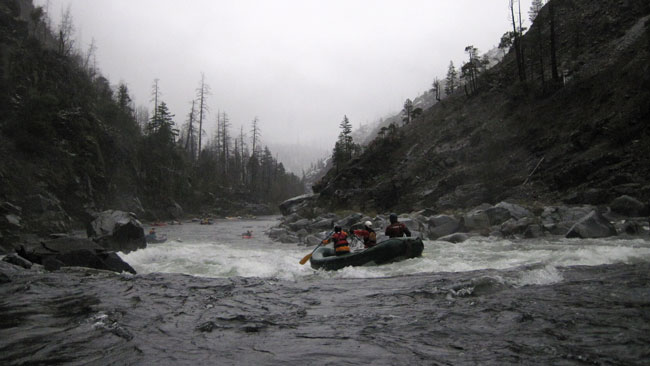
Mid-rapid on a quick paddle down the Hood last week, Alan turns to me and asks if I'd ever run the Illinois? I said I hadn't and he asked if I wanted to join a raft trip next weekend. I thought to myself, 'hmm, that sounds kinda cold', and out loud I said, "Sure, sounds great!". Oddly, I'd never really spent much time with rafts in my years as a boater, opting instead for ultralight self-support missions, but with a recent invite to run the Grand Canyon, I thought it might be prudent to learn what this rafting thing was all about. This Illinois trip was organized by Will Volpert, lifelong raft guide and current unofficial king of the illinois with nearly 30 descents to his credit. On Will's website oregonrafting.org, his guide to the Illinois begins: "A lot of people talk about running the Illinois, not so many do it..." With over a hundred class 3, ten solid class 4, and one class 5-, all packed into 30 miles of remote steep bedrock canyon, the Illinois is as good a whitewater run as you'll find anywhere. The problem, however, is flow. With a huge rain-fed drainage and nearly no topsoil the river fluctuates from below runnable to suicidally high during it's entire season. You'll know if you can run the Illy when you are standing in front of it, and boaters who have refused to back off at high water have paid with their lives. With cold weather, perpetual rain, and variable flow, the Illinois doesn't just hand itself to you like the Rogue or the Deschutes, you have to want it, and I did.

So it was that Leann and I found ourselves in Selma, Oregon, a little nowhere town on hwy 199 in the Siskyou mountains. Over the course of the night several dozen people filtered into the house we were staging at, and by morning we had a motley crew of oarboaters, catarafters, R2ers, kayakers, a guy who'd never been on a whitewater trip, and even one gal who literally heard about the trip from friends in a bar at 10pm the night before!

We used Affordable Shuttles to stage vehicles on the other end of the river, a circumspect drive down to California and back up the Oregon coast. That morning they drove us to the put-in on the steep winding backroads of the Kalimiopsis wilderness.

We unloaded four oarboats, four cats, two paddlerafts, three kayaks, and a dearth of gear.

I'm not certain that anyone ever actually knew how many people or boats were on this trip.


I'd like to consider myself someone who's always game to suck down a PBR, even at 10am, but with the sleet coming in waves, the idea of consuming anything cold seemed pretty unappealing, not for these guys though!

Tequila on the other hand is a different story.

Leann, the river-ninja, still shivering in a drysuit and two layers of fleece.

Before shove-off, Will calls a meeting. Looking at all these sopping wet, freezing people in the the middle of nowhere, I was struck by the thought that to be here today you'd have to be:
a) extremely passionate about boating
b) a bit mentally unbalanced
c) intoxicated
I think all three groups were well represented in this circle.

Will, our fearless leader, heads downriver with enough people and supplies to invade a foreign country.

I became fascinated with the Catarafts over the course of the trip. On one hand, a cat is a waste because a raft of similar weight and length could carry a lot more gear and people, but on the other hand, the cats are nimble and forgiving offering what looked to me like a very fun rowing experience. That, and they just looked kinda science-fiction, like mechanical water striders, which is pretty cool.

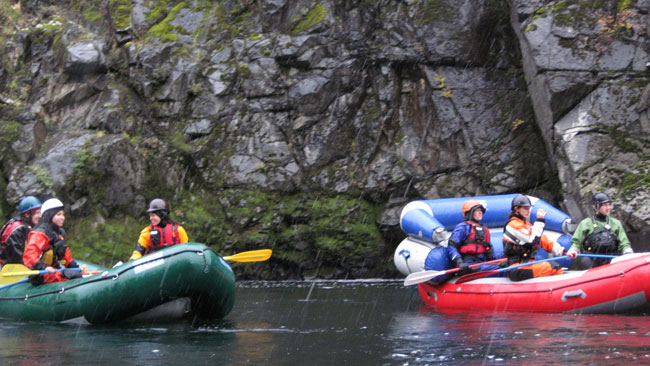
Our two paddlerafts, piloted by Hans and Tom, notable for being some of the most talented, and boldest, R2ers in the Northwest. Yes, that is a COUCH strapped onto Tom's raft. Giggling uncontrollably down the entire river, the party never stopped on the R2's.

Alan rocks a well used Eskimo kayak, a visual pun with it's snow covering.

It wasn't a half mile before we started dropping through closely spaced class 3 rapids.
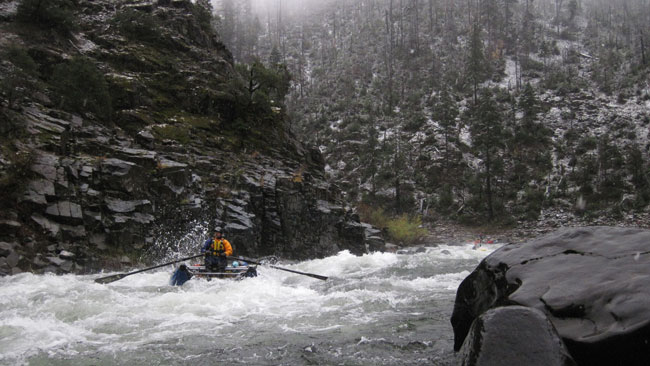
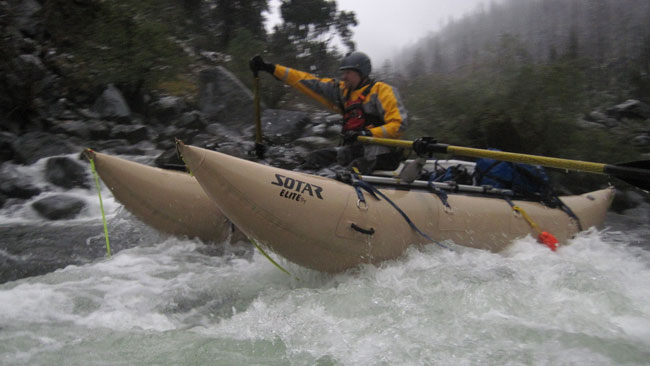
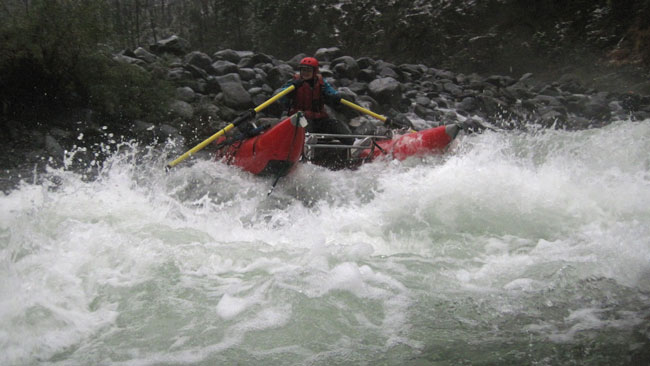

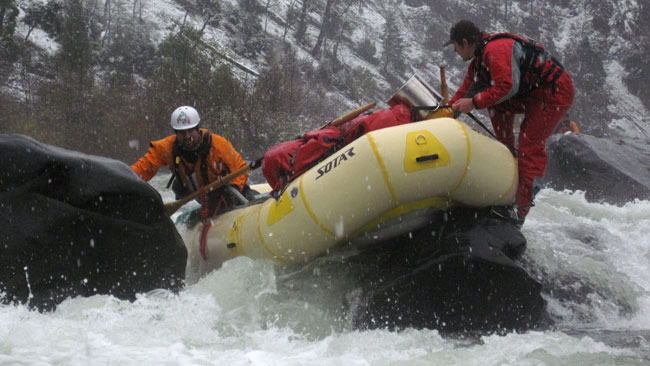
With flows at the lower end of runnable, we suffered an occasional stranding in the tight, bouldery drops.
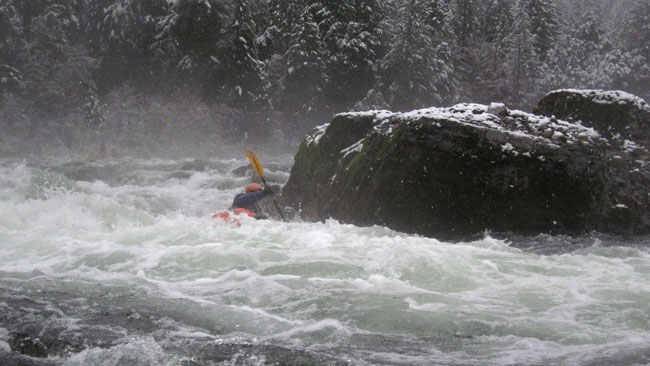
The rafts and cat boaters could stand up to scout the drops before crossing a horizon line, but for us kayakers, it was more of a drop-and-dodge situation. Not really a problem at this flow, but I saw a lot of boulders that would form macking holes at higher water. In fact, I think it's safe to say that unless you want to stop and scout every class 4 rapid, as a kayaker you can expect to get worked at least a couple times on the Illinois at moderate to high flows.
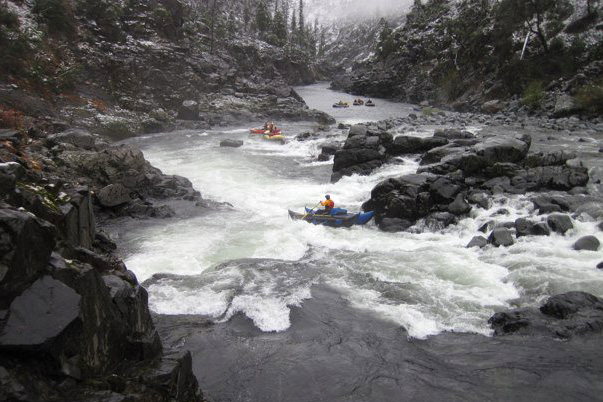
York Creek, our first class 4 drop. (photo David Pool)
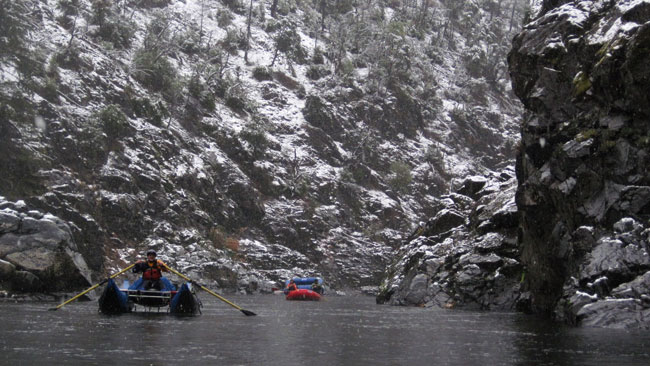
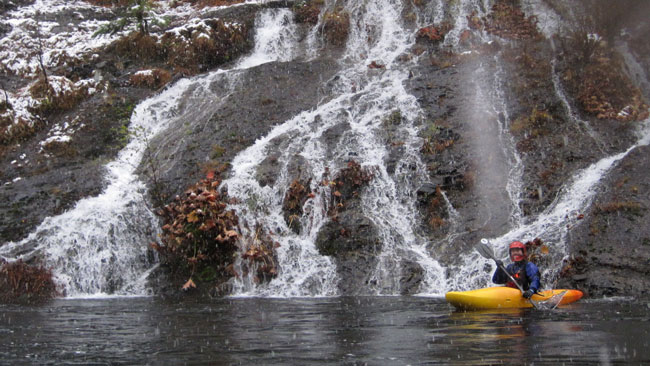
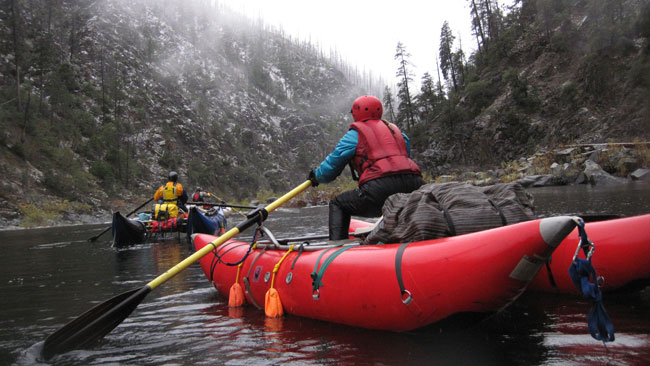
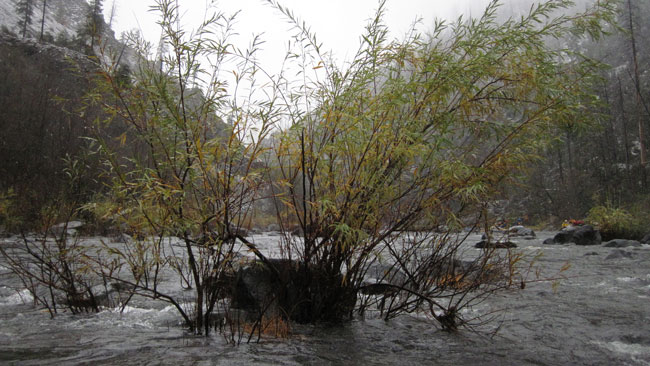
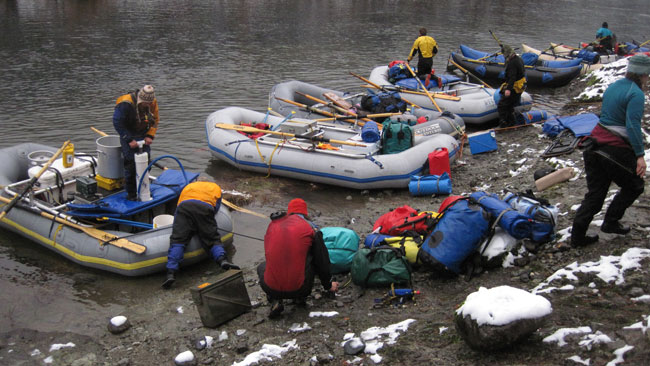
One problem we faced was finding a campsite suitable for 24 people. We stopped for the night at Pine Flat and set up a fire line, making short work up moving the zillion and a half drybags up the steep icy slope.
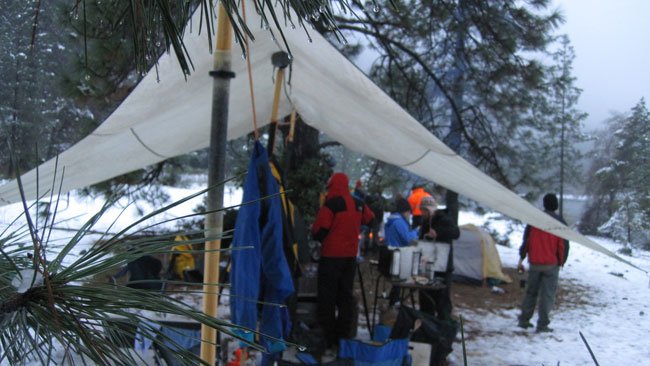
Will has been doing this so long he operates on autopilot, quickly and efficiently setting up tarps and kitchen. Acutally, nearly everyone in our group was highly experienced, and many were professional guides. In a bustle of activity Pine flat was quickly transformed into a nearly-civilized encampment.
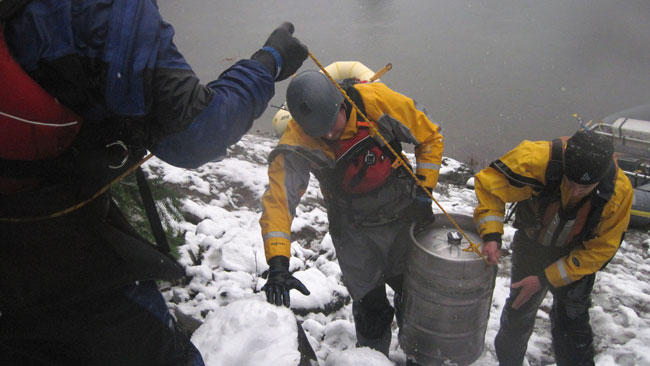
Every stereotype I'd held about rafters being a bunch of loud, over-consuming hedonists is confirmed by this photo. A far cry from my creekboat, bivvy sack, and bottle of scotch, and under the circumstances, that's a good thing. I especially appreciated the large box of dry firewood.

Dusk at Pine Flat.
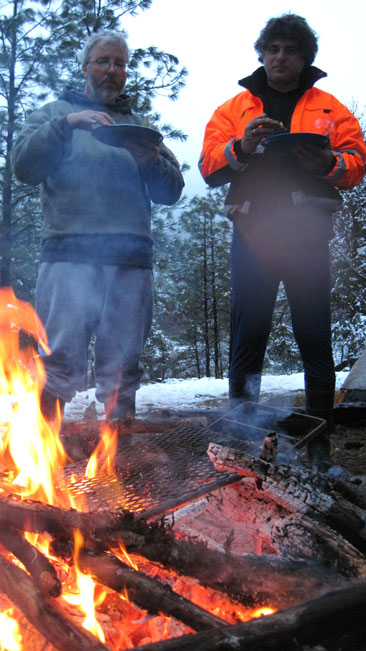
Fire and breakfast the next morning.
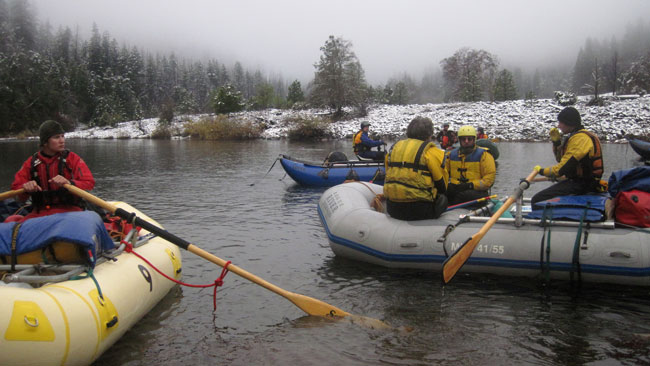
Slow-packers being one of my pet-peeves in life, I had assumed I'd spend half the morning freezing and waiting, after all, how could anyone pack so much gear in less than 3 hours. Considering that many people were still asleep at 7:30, and that Will and Dana cooked a full breakfast, I was pretty surprised when we shoved off around 9am.
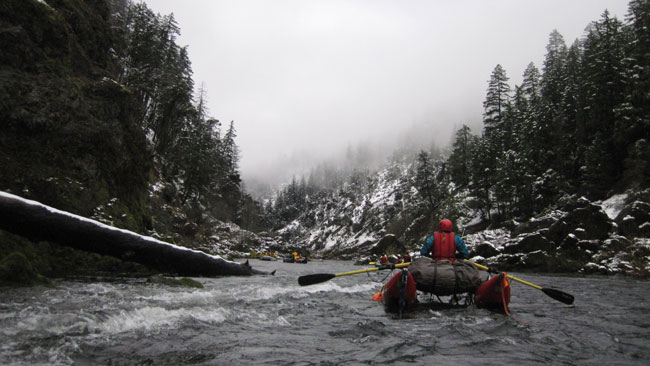
Down the canyon with 21 miles and most of the hard rapids still ahead, and about 7 hours of daylight.
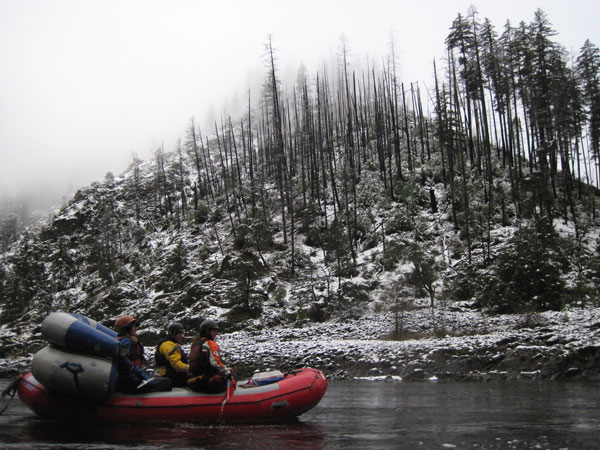
In 2002 the massive 500,000 acre 'biscuit' wildfire burned the entire Kalmiopis Wilderness, it's effects are still visible today, miles of blackened poles adding a somehow appropriate beauty to the dark bedrock canyons.
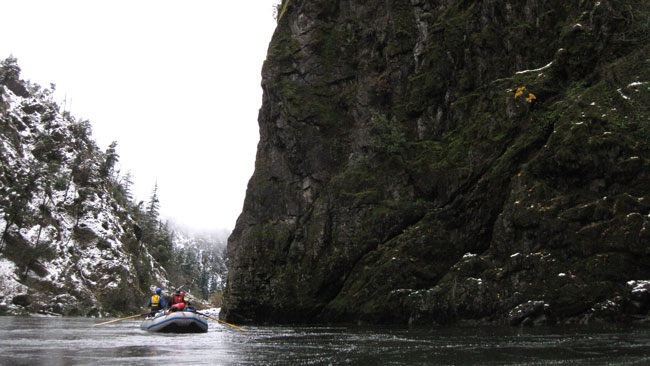
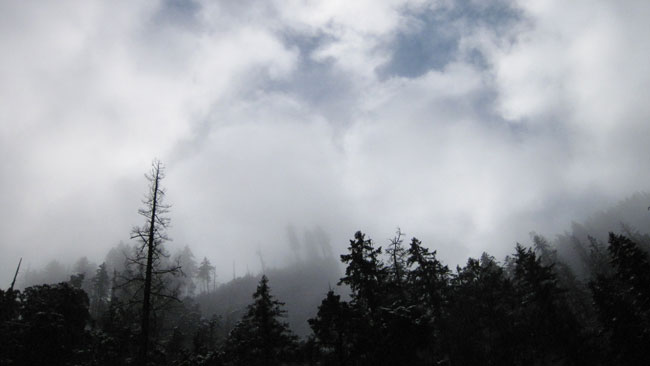
Like an apparrition the sun broke through the fog.
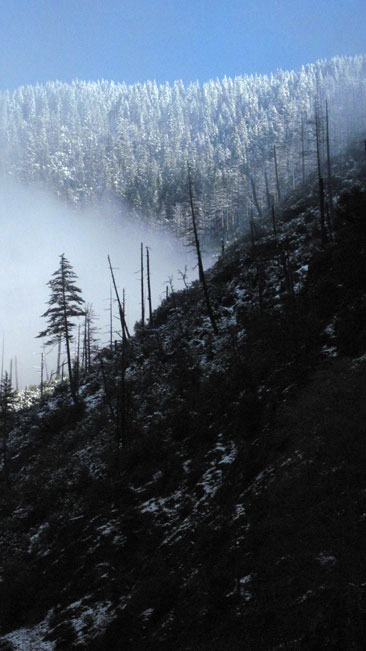
The high slopes gleamed like crystal castles in the sky.
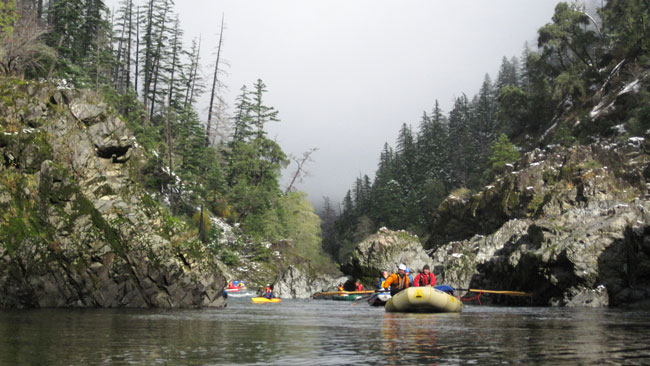
...and for a brief moment spirits lifted and all was well.
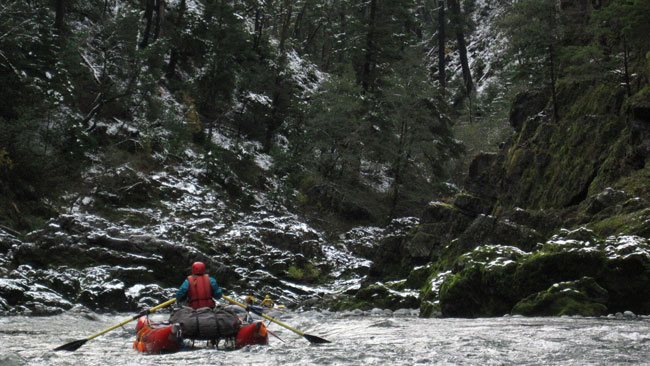
A fleeting sentiment, soon the skies closed and issued a soaking upon us that was only a degree or so warmer than snow. 36 degrees and raining, the coldest kind of cold. The canyon walls closed in to form a series of tight, steep gorges that signalled the approach of the crux section of this run.
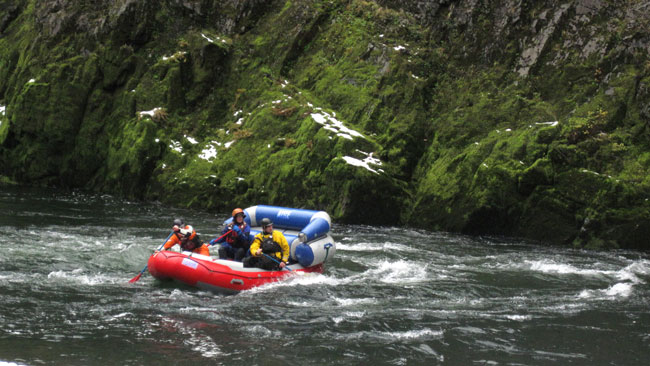
We eddied out above Prelude.
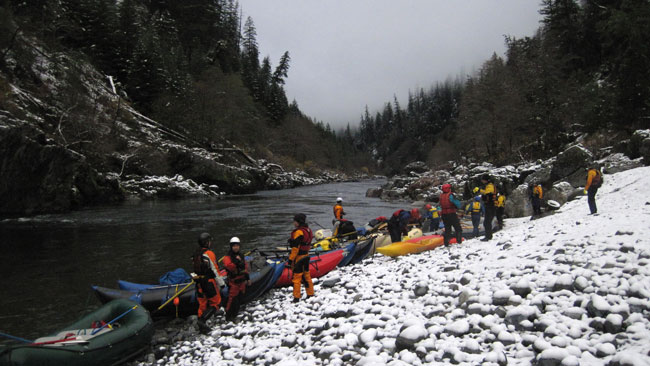
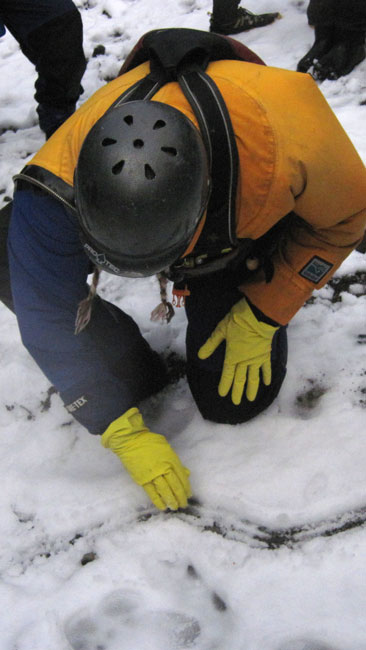
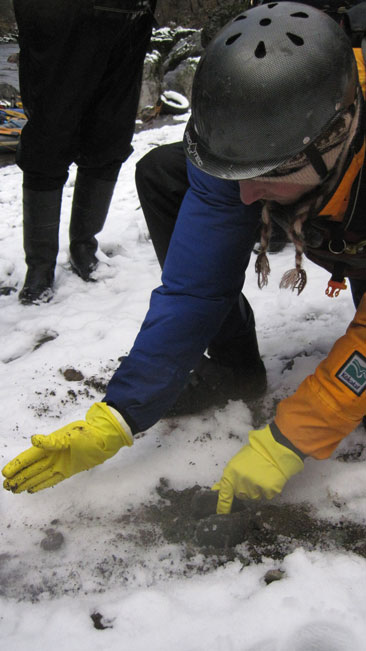
Using snow and rocks Will gives us the beta on the Green Wall rapid. To make it off the the river before dark we need to move people through the rapid quickly and efficiently, without wrapping any of the rafts or cats on the exposed midstream boulders.
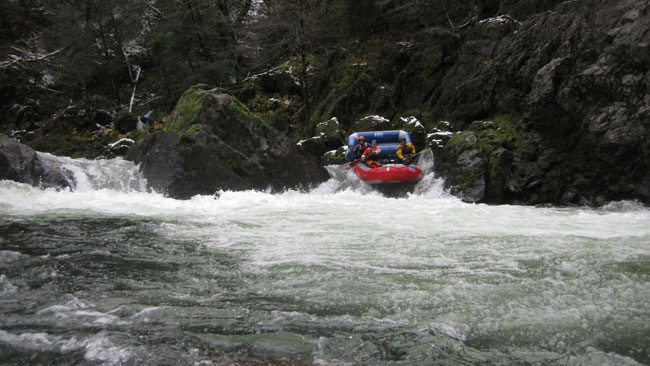
Before Green Wall is Prelude. The rafts and oarboats took this line but from above I couldn't assess how sticky the hole was on this side, so instead David, Alan, and I chose a route on river-left that required a strong drive to miss a nasty midstream rock. I'll take a moment here to say that I haven't been in a whitewater boat more than three times since the end of summer, when I make the annual transition from surfing and sea kayaking, so my skills were still pretty sloppy.
I slammed into the upstream face of that nasty rock with a loud thunk and a dramatic splash (I was told), and briefly pinned while my boat ground it's way around the boulder tearing my hand off the paddle as I went. It took a moment to get situated and roll up, at which point I exclaimed with astonishment, "I ate shit!". It didn't give me a hit of adrenaline, which was weird, but I was a little concerned that I'd just f-ed up a class 3 move and the next rapid was the Green Wall.
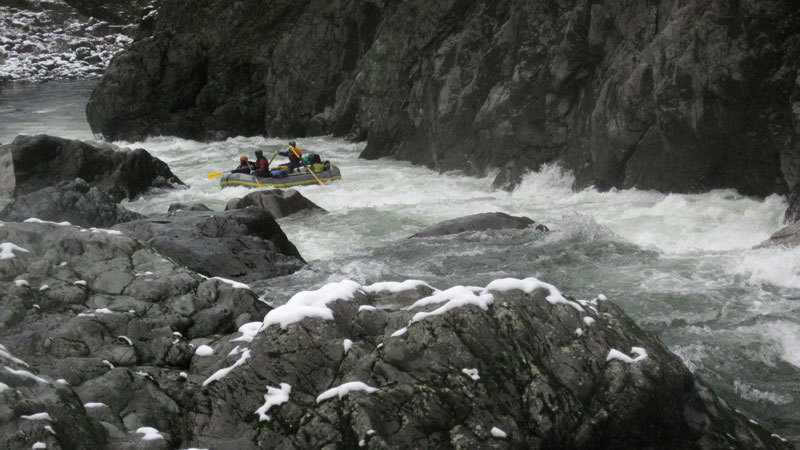
Everyone ran the top of the Green Wall blind, and using radios we staged a couple rafts at a time in an eddy about halfway down so first-timers could get a quick look. Will went first, with Leann and Dana on paddles, bombing the entire thing from memory.
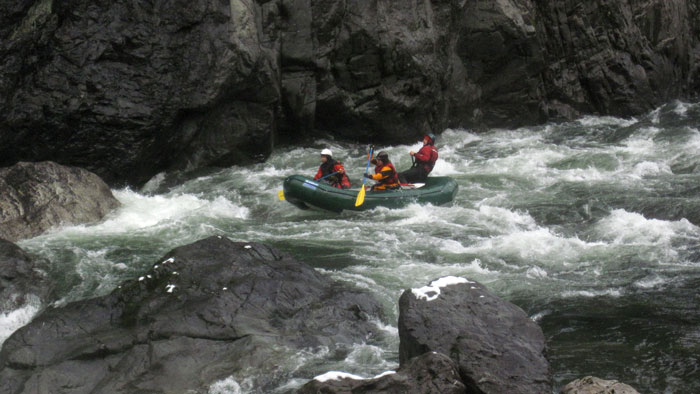
Hans and Brie's paddle raft approaching the first boulder fence.
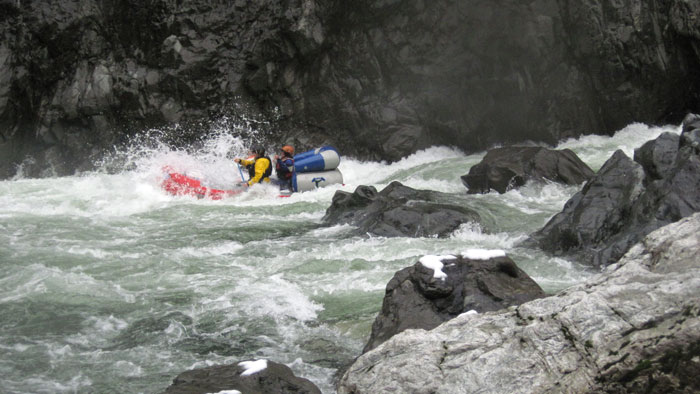
The 'couch boat' punches the second hole. At 800cfs the Green Wall is rocky yet merciful. At the higher end of reasonably runnable flows these boulders turn into giant boat eating holes!
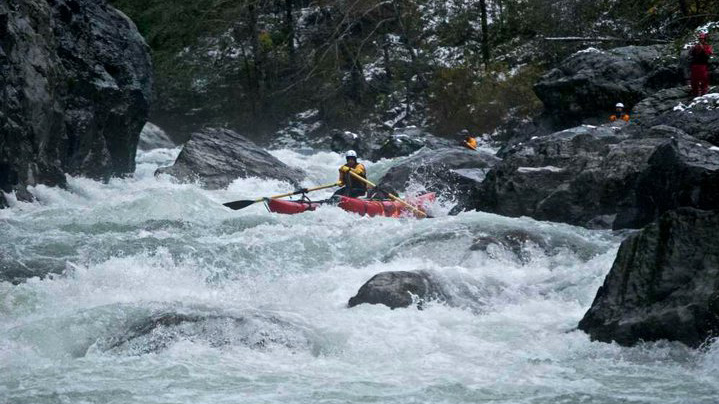
Skip pilots Lacey's cat down the rapid. (photo by Dana Woodruff oregonrafting.org)
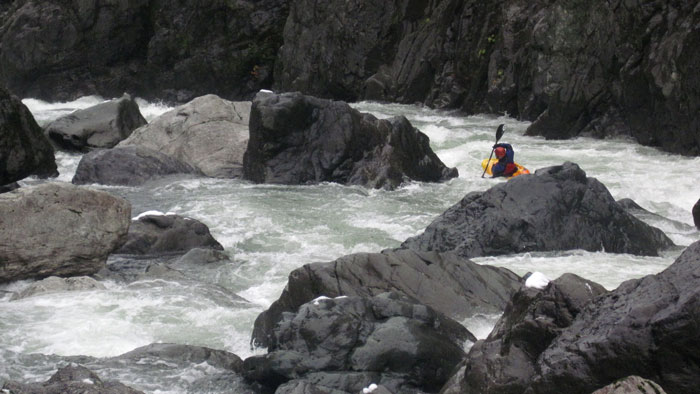
...and finally it was time for the kayakers, who found a nice little sneak route on the left to avoid the two munchy looking holes in the middle, followed by a fast drive to the middle to avoid the downstream boulder sieve, leaving one moderate, but flushing hole to punch at the very bottom. It was a clean class 4 line in a gorgeous big rapid, and for no reason that I could even begin to figure out, it scared the crap out of me. I'm generally a pretty timid boater and I don't usually run class 5, but this looked like a good line, and I wanted to run it, but it was like there was an 800 pound gorrilla of dread that I couldn't wrestle down. The following conversation ensued between my concious brain and my unconcious brain:
Dude, people who have never rafted before just ran it
Nope, super scary
It's not scary, it's one easy drive
Like the one above prelude, right?
C'mon, David just ran it, David has been boating 2 years, he's barely a class 4 boater.
No way, look at all those rocks, seems pretty dangerous to me
Look at the portage, THAT looks dangerous to me
if you get munched you're gonna feel like an idiot
I'm gonna make people late if I walk it
does it look like fun to you right now
not really
alright, then you're not doing it for the right reasons, boat on the shoulder son.
Fine.
So I sheepishly became the only person to walk the Green Wall that day, and curiously, the intense fear I felt completely vanished after I did. I have no clue if it was just me being a pansy or if it was 'the voice', as in, the voice from inside that tells you not to do something that is about to hurt you. What it came down to is that if I ran it it would have been to save face, which is never a good enough reason to run a hard rapid.
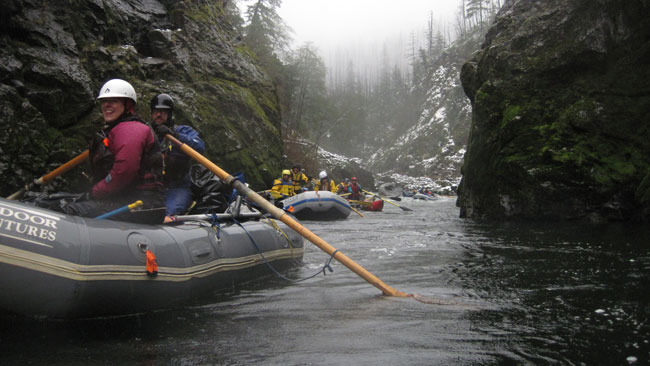
Stoked paddlers in tight bedrock gorges below the Green Wall.
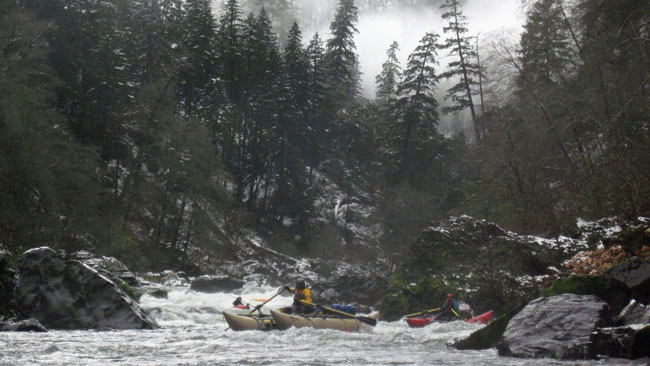
Below Green Wall is a tightly spaced series of solid, fun, class 4 boulder-drops. I didn't get a lot of photos because I was busy boating at the time. This is an awesome section of whitewater but I could also see this being a gauntlet of kayak eating holes with three times the water.
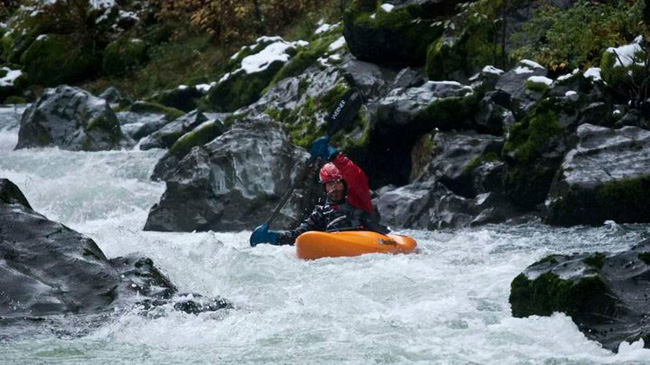
Me. (photo Dana Woodruff oregonrafting.org)
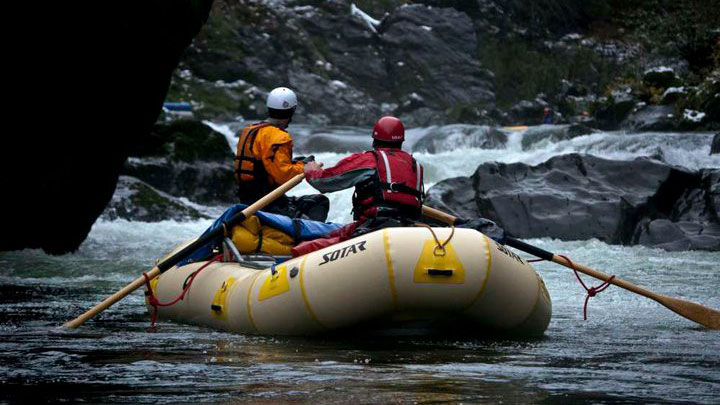
A typical drop, not sure which one. (photo Dana Woodruff, oregonrafting.org)
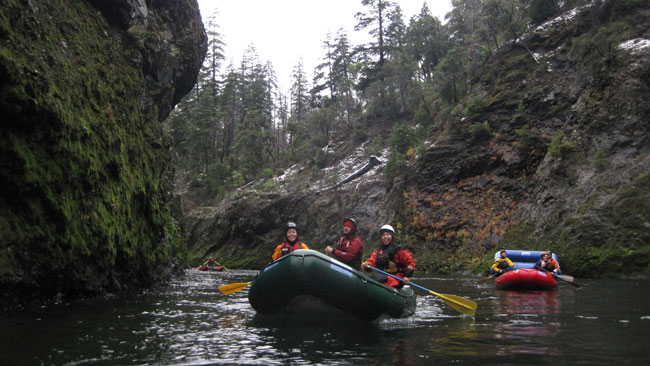
The canyon eventually subsides into a long series of sheer walled pools that I've heard rumors of sea kayakers exploring in the summer, which seems like a neat thing to do.
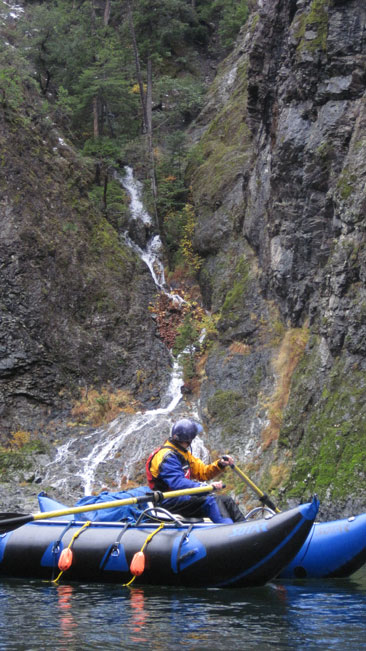
Waterfalls pour in from all sides in this lower section.
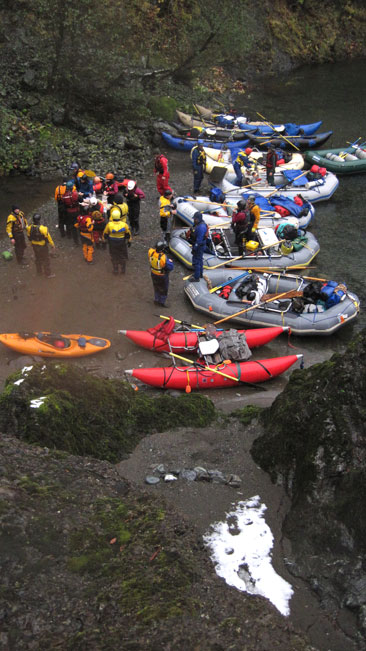
We stopped at a small beach surrounded by sheer walls, appropriately named "waterfall camp" for the cascades tumbling down the slopes behind it. Will and Dana produced a table with a full lunch spread as though by magic, I hardly saw them unpack it! Everyone spent fifteen minutes devouring sandwiches. With all that shivering I think we were burning a thousand calories an hour!
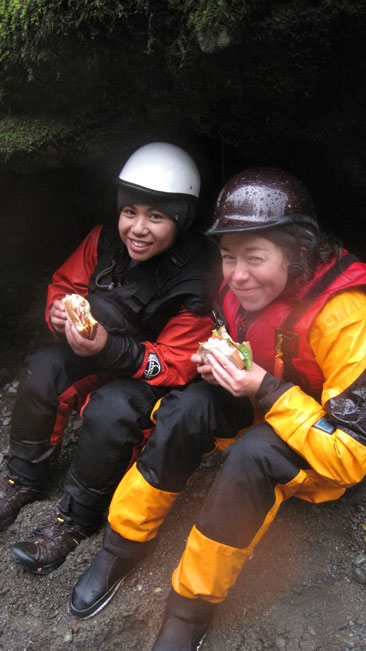
I found these two huddled in a tiny cave.
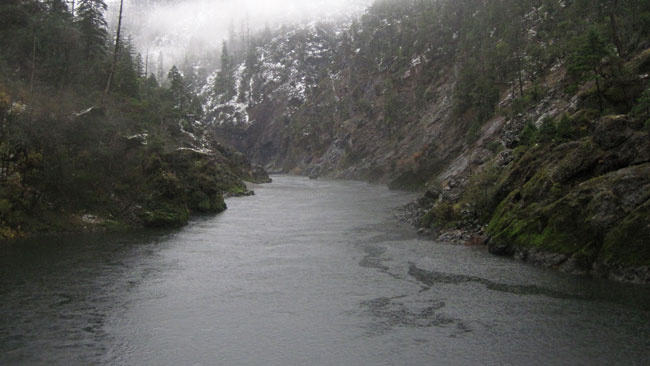
The long rainy flatwater ahead.
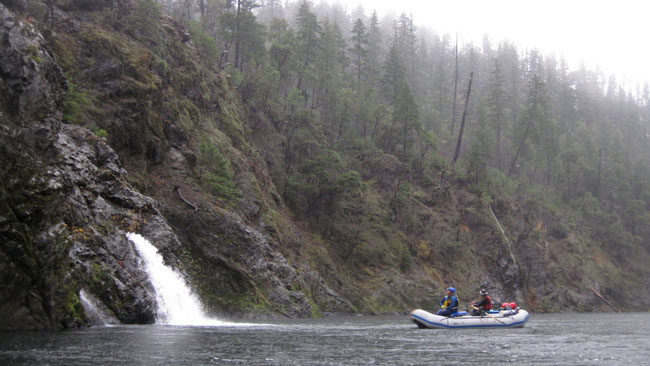
There was still plenty to see.
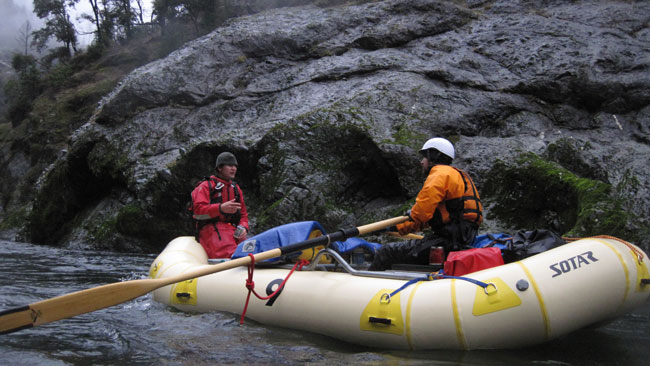
I passed the time paddling from boat to boat, chatting and eavesdropping. Here George gives a detailed description of all the decent beers available in cans nowadays.
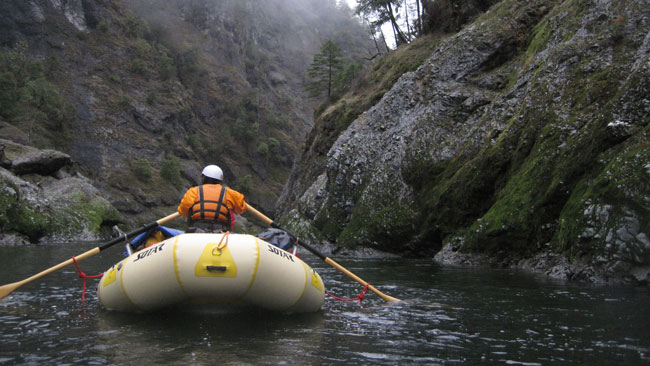
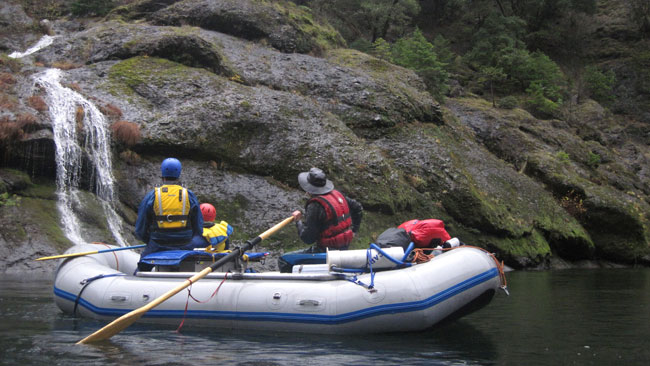
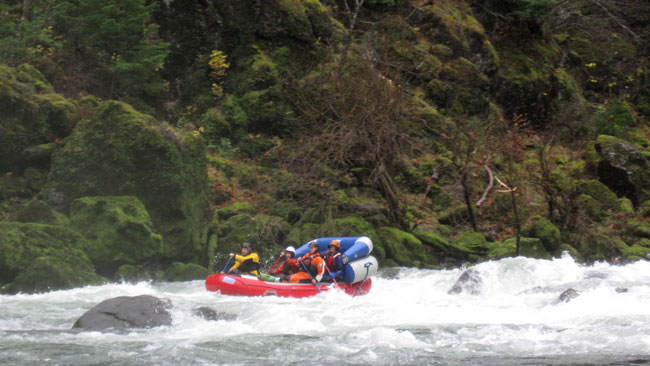
Once in a while we'd even get lucky and find a decent little drop.
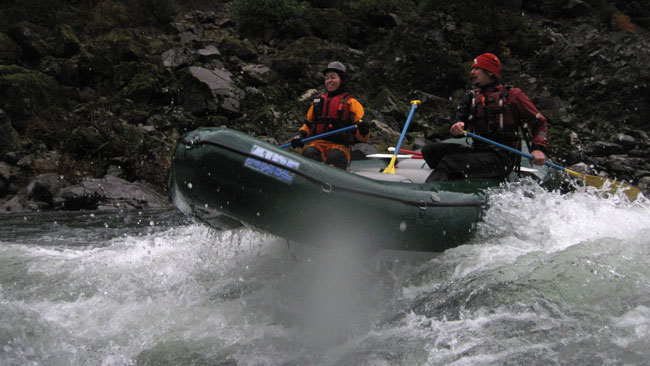
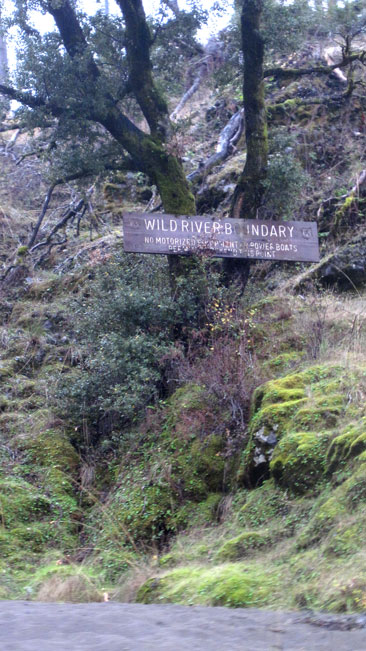
100 yards from the finish line, and one half hour before darkness.
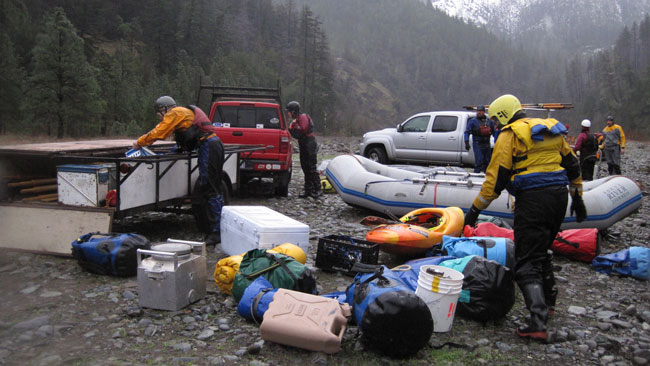
The lure of a warm shuttle van has a powerful effect on people. The entire crew was packed and ready to drive away in an amazing 38 minutes!
Conclusion:
First, let me say THANK YOU SO MUCH TO WILL AND DANA who basically gave some of us newbies a guided tour of the Illinois (which goes for about a grand if you gotta pay for it). I understand the stoke to share a special rugged place, and I also understand the work that goes into it. I'm sure I speak for everyone when I say that you guys rule! Really I want to thank everyone who came out, it was so cool to meet all of you and get a view into a different way of running rivers. Leann and I are seriously talking about getting a raft or a cat so I hope I can keep in touch with a few of you.
As far as the river itself goes, the Illinois isn't the hardest thing going, but at any flow it demands a healthy respect. You're a long way from help in there is something goes wrong. On the scenery scale the Illinois gets an A+, the combination of the Biscuit Fire and the grey/black exposed bedrock seems to compliment the gravity of the whitewater. The Illinois definately has it's own unique feel. I feel very lucky to have run it with such a talented crew. Upper Owyhee in the spring anyone?
A quick note about alcohol: upon re-reading this report I think it might give a false impression of people boozing it up
on the river, a beer or two yes, getting loaded and running hard whitewater no. Just wanted to make that clear.
Back to Class IV whitewater kayaking blog
